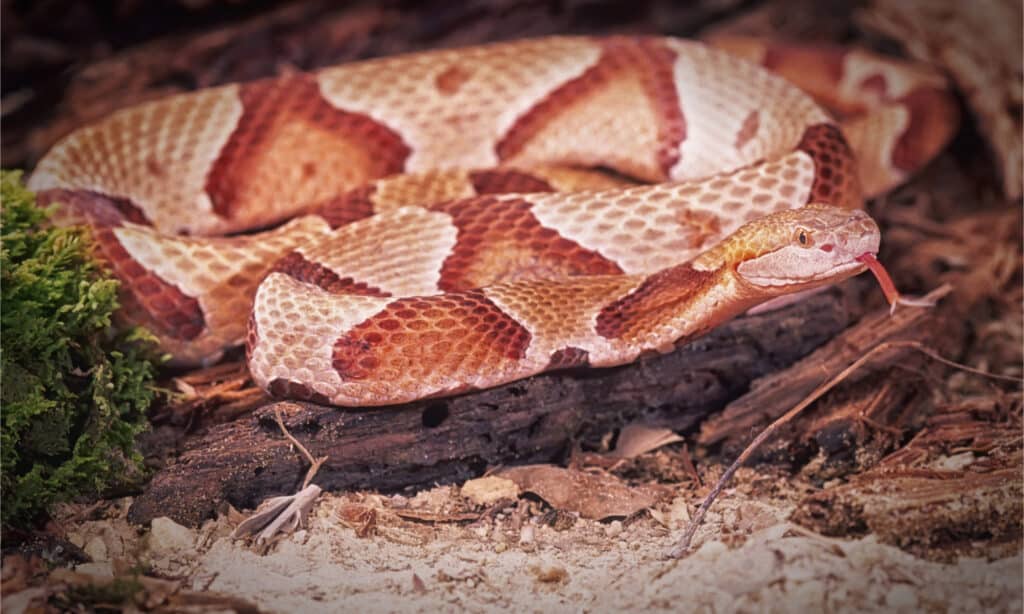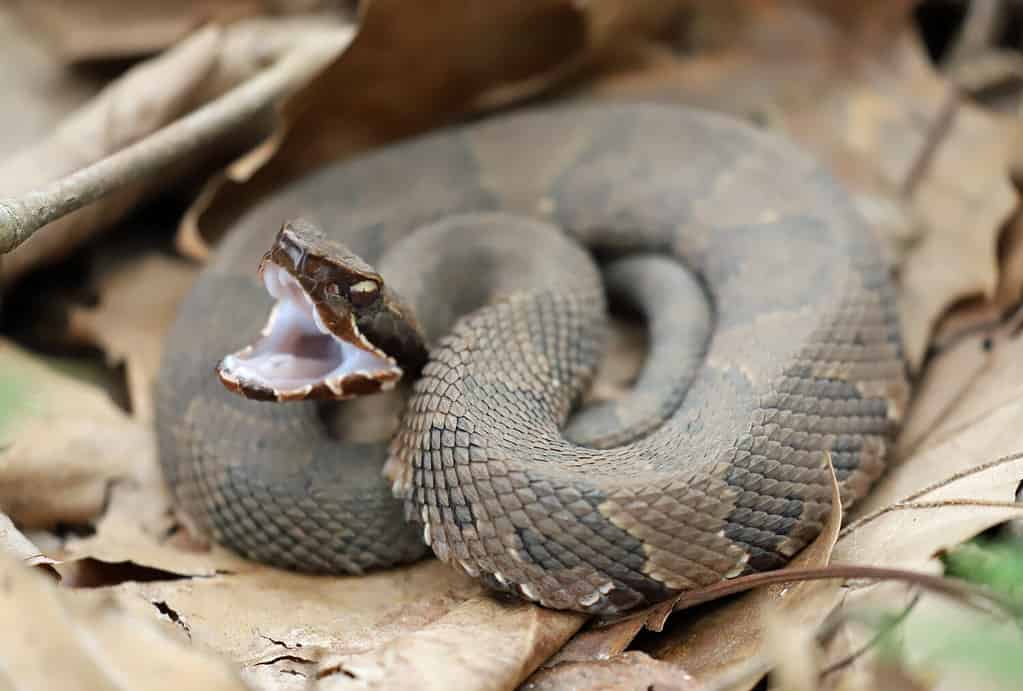Pennsylvania is home to 18 nonvenomous and 3 venomous snake species, totaling 21. One of the state’s most widespread and venomous snakes is the copperhead. Copperheads are solitary animals and stay that way except when they mate, but many also use communal dens when the weather turns cold. This article takes a look at venomous copperheads in Pennsylvania: where they live and how often they bite.
What Copperheads Are Found in Pennsylvania?
There are two known species of copperheads living in the southeastern United States. Pennsylvania is home to only one the eastern copperhead.
Eastern Copperheads

The copperhead’s scales are keeled, and their eyes have vertical pupils that make them resemble cat’s eyes.
©Creeping Things/Shutterstock.com
Eastern copperheads aren’t long snakes. Like all pit vipers, they have heat-sensing pits that help them hunt their prey by detecting infrared waves. The species is known to have thick bodies and ridged or keeled scales
As babies, these snakes exhibit impressive hunting skills. Research suggests that they use their brightly-colored tails to hunt. They use their tails to lure or attract unsuspecting amphibians.
Reproduction
Male and female copperheads do not stick to a single partner. Male copperheads seek out the females and are sometimes battled first to prove themselves. Winners are allowed to go on with the mating process. Since snakes hardly recompete after being defeated once, male copperheads rarely compete again if they lose to the females.
If male copperheads are successful, they might produce and coat females with pheromones to make them unattractive to other male copperheads. If female copperheads mate in the fall, they will store their sperm in their bodies until after hibernation.
Feeding
Eastern copperhead hunt using their heat-sensing pits, which have a membrane that can detect or spot infrared radiation in living bodies. This helps them detect the movement and presence of their prey. Eastern copperheads feed on a wide range of animals including small snakes, small birds, insects, lizards, and mice.
How to Identify Copperheads in Pennsylvania

Copperheads are thick pit vipers that measure from 20 to 37 inches and weigh anywhere from 0.3 – 0.8 pounds.
©outdoorsman/Shutterstock.com
Copperheads are large snakes that measure from 20 to 37 inches on average and anywhere from 0.3 – 0.8 pounds in weight. They also have thick bodies and ridged or keeled scales.
One way to distinguish these species from others is by their crossbands which run along their sides. Usually, they are colored deep brown to pinkish-tan.
Where Are Copperheads Found in Pennsylvania?
Eastern copperheads are pretty widespread in the state of Pennsylvania. They are found in every part of the state except the northern third.
What Time of Year Are Copperheads Most Active in Pennsylvania?
Pennsylvania’s eastern copperheads are most active during warmer weather. They are active during spring and brumate during winter. Daily, they are more active in the late afternoons and evenings.
Where Do Copperheads Like to Hide?
Copperheads in Pennsylvania, like many snakes, prefer to habitats with easily accessible hiding spots and good access to sources of food. They seek out wooded regions, rocky regions, grassy places, and piles of leaves, sawdust, and wood. Hiding areas also include spots in yards that are cluttered or shaded (such as garden hoses, shed roofs and outside tables), compost bins that are neglected, and abandoned buildings.
How to Keep Copperheads Out of Your Yard in Pennsylvania
Since copperheads are so widely spread in the state of Pennsylvania, running into them now and then is common. Here are some helpful tips to keep copperheads away from your yard:
- Remove hiding places for prey such as mice, rats, and birds and their eggs. Snakes follow the prey.
- Ensure that the vegetation around your home isn’t dense or overgrown and is kept trimmed so it is less inviting for snakes, who can hide in tall grasses and underneath shrubs.
- Ensure that your surroundings are not littered with piles of rock, debris, or wood, in which copperheads can camouflage themselves.
- Make sure to remove fallen trees or chopped logs in the yard as snakes like to hide under logs.
- Seal any crevices or cracks in drywall, stucco, basement, crawl spaces or garden shed with silicone to stop copperheads from entering.
- Remove woodpiles or keep them on a rack at least 1 foot off the ground so the snakes cannot hide under the wood.
- Try to avoid having water sources in your yard that may attract prey such as frogs for copperheads, or if you have a water source, keep the grass short and don’t provide anything that will give snakes any cover.
- Install snake fencing that has fine mesh too small for copperheads to squeeze through.
- Consider getting chickens or Guinea hens, as they can keep snakes at bay and eat up any bugs and mice that copperheads also eat.
What To Do If You See a Copperhead in Pennsylvania?
If you spot a copperhead in Pennsylvania, remember to stay calm. Copperheads often freeze at first when they spot humans. Most snakes slither away to avoid being stepped on but copperheads do not. If you spot a copperhead, take the opportunity to get away calmly without startling the snake.
Once you’re away, contact the appropriate authorities if you spotted the snake in your home. Remember not to kill snakes. Like other animals, they are an important part of the ecosystem as they keep several pests in check.
What To Do If You Get Bitten by a Copperhead in Pennsylvania
If you get bitten by a copperhead in Pennsylvania, here are steps to follow:
- Get as far away from the snake as possible. Your first thought should be about safety.
- Once you are safely away, contact emergency services immediately.
- Sit still as movements can help the venom spread.
- Do not attempt to suck out the venom or cut off the infected parts.
Copperhead Bites and Venom
Copperhead bites are extremely painful due to their long solenoglyphous fangs. They bite more people than any other snake in the United States each year. Although they are one of the least venomous pit vipers known, their bites are notoriously painful and, over the years, responsible for a few deaths.
While it is important to note that the mortality rate of their bite is extremely low, it is also important to acknowledge they are not harmless. Pain, dizziness, and swelling, as well as intense nausea, are symptoms of a copperhead bite.
It is common to experience intense pain, tingling sensations, swelling, throbbing, nausea, and dizziness. In some cases, copperhead bites damage the muscle and bone tissue of their victim.
Copperheads have an estimated lethal dose of around 85- 100 mg. However, on average, they yield 26 mg of venom — with a maximum of 85 mg. Consequently, their bites, most times, aren’t fatal. According to Stephen W. Miller, a research scientist, between 2004 and 2018, 1,452 snake bites were reported to the Pennsylvania Poison Control Centers, 847 of which were venomous.
Copperhead Bite and Death Statistics
- 1 in 500 bites from venomous snakes results in death.
- About half of all snake bites are dry bites. Dry bites are usually used by snakes as warning bites. A dry bite has no venom injected. About 8,000 people get bitten by venomous snakes in the US each year.
Are Copperhead Snakes Aggressive?
Copperheads are not aggressive snakes. Most of their bites are either dry bites or have low venom yield. They often bite to warn their attackers if they are frightened or stepped on.
Venomous Snakes in Pennsylvania
Pennsylvania is home to three species of venomous snakes, which are copperheads, timber rattlesnakes, and eastern massasaugas. Let’s take a look at timber rattlesnakes and eastern massasaugas.
- Timber Rattlesnake: Timber rattlesnakes are known for their dangerous venom. Some timber rattlesnakes have a neurotoxin, but not all.
- Eastern Massasauga: Eastern massasaugas (Sistrurus catenatus) are venomous rattlesnakes with cytotoxic venom that destroys tissue.
What Is the Most Venomous Snake in Pennsylvania?
The timber rattlesnake is the most venomous snake in Pennsylvania. However, the eastern copperhead and eastern Massasauga are also dangerous.
What State Has the Most Snake Bites?

The venomous cottonmouth snake is among the snakes responsible for snake bites in North Carolina.
©KF2017/Shutterstock.com
In Pennsylvania, there are approximately 104 reported snake bites that occur annually. While it may sound like a lot, there are some states that definitely outrank Pennsylvania for snake bites.
What state ranks the highest in snake bites? That would be North Carolina. This southeastern state’s bite rate is 157.8 bites per million population per year. How does that average out? Well, the population as of 2021 was a little over 10 million (10.55 to be exact). If we were to just figure it off of 10 million, that would mean that there are roughly 1,580 reported snake bites per year.
The top 6 states for reported snake bites are as follows:
- North Carolina–157.8 bites per million
- West Virginia–105.3 bites per million
- Arkansas–92.9 bites per million
- Oklahoma–61 bites per million
- Virginia–48.7 bites per million
- Texas–44.2 bites per million
In North Carolina, there are 6 different kinds of venomous snakes: copperhead, cottonmouth, timber rattlesnake, pigmy rattlesnake, eastern diamondback
The photo featured at the top of this post is © Creeping Things/Shutterstock.com
Discover the "Monster" Snake 5X Bigger than an Anaconda
Every day A-Z Animals sends out some of the most incredible facts in the world from our free newsletter. Want to discover the 10 most beautiful snakes in the world, a "snake island" where you're never more than 3 feet from danger, or a "monster" snake 5X larger than an anaconda? Then sign up right now and you'll start receiving our daily newsletter absolutely free.
Thank you for reading! Have some feedback for us? Contact the AZ Animals editorial team.






